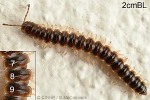Cook Islands Biodiversity Database
Species Page
Oxidus gracilis
Veri TinitoShort-flange Millipede
Multimedia & Additional Resources
| Type | Description | Download |
| Adult and detail of mid-body | 49KB | |
| Compare species | 83KB |
General Information
Cook Islands Distribution
| Southern Group: Present Makatea: | ||||||||
RR |
MG |
AT |
MK |
MT |
AK |
PL |
TK |
MN |
++++ |
P |
|||||||
| Northern Group: | |||||
TN |
MH |
RK |
PK |
NS |
SW |
Scientific Taxonomy
Oxidus gracilis (C. Koch, 1847)
SYNONYMS: Orthomorpha gracilis
TAXONOMY: ANIMALIA; ARTHROPODA; ATELOCERATA; DIPLOPODA; Chilognatha; Polydesmida; POLYDESMIDAE
More Information
GENERAL NOTE: A major urban pest in the USA, regularly invading houses and buildings, especially in hothouses and greenhouses, hence its popular names of Hothouse Millipede and Greenhouse Millipede. It is also the most common milliped throughout Hawaii. [Shelley, R.M. & Lehtinen, P.T (1998)] The common flat milliped of the Cook Islands and French Polynesia, from the lowlands to the highest mountains, in leaf litter from forest slopes to beside streams. Asiomorpha coarctata has not been found in the mountains of Rarotonga, and is less common on the lowlands.
Vouchers & References
Vouchers:
Cooks: mention in BPBM Bull.113 (1935) p.133.
References:
Special Reference: Shelley, R.M. & Lehtinen, P.T (1998) Introduced millipeds of the family Paradoxosomatidae on Pacific Islands (Diplopoda: Polydesmida), Arthropoda Selecta 7(2):81-94; Shelley, R.M. & Bauer, S.B. (1997) The Milliped Family Paradoxosomatidae in the Hawaiian Islands (Diplopoda: Polydesmida), Records of the Hawaii Biological Survey fro 1997 Part 2: Notes, p.43-53
Data Update History (information):
zTX, zB02, zM04a, zup05b, zD02
Web Resources
Citation Information
McCormack, Gerald (2007) Cook Islands Biodiversity Database, Version 2007.2. Cook Islands Natural Heritage Trust, Rarotonga. Online at http://cookislands.bishopmuseum.org. ![]()
Please refer to our use policy.

